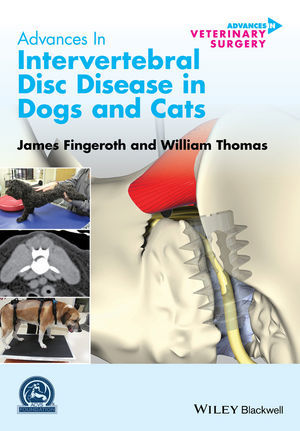
Advances in Intervertebral Disc Disease in Dogs and Cats -

Descripción
Descripción completa de: Advances in Intervertebral Disc Disease in Dogs and Cats -
Author : James Fingeroth / William L. Thomas
Language: English
Finishing : Hardcover, 336 pages
ISBN : 978-0-470-95959-6
Edition Number: 2015
Description:
Advances in Intervertebral Disc Disease in Dogs and Cats defines our present knowledge of this common clinical problem, compiling information related to the canine and feline intervertebral disc into a single resource. As a comprehensive, focused work, the book is an authoritative reference for understanding and treating disc disease, providing a sound scientific and clinical basis for decision making. Offering an objective synthesis of the current literature, the book supplies guidance on the approach to a potential disc rupture, surgical and medical strategies, and management of the patient.
Offering a complete understanding of intervertebral disc disease, the book describes and discusses the controversies and issues surrounding this topic, acknowledging the gaps in our knowledge. Advances in Intervertebral Disc Disease in Dogs and Cats presents up-to-date, reliable information on this common condition for veterinary surgeons, neurologists, and general practitioners.
Table Of Contents:
SECTION 1: INTERVERTEBRAL DISC STRUCTURE AND FUNCTION
- 1. Embryology, innervation, morphology, structure and function of the canine intervertebral disc
- 2. Biomechanics of the intervertebral disc and spinal motion segments
- 3. Comparisons between biped (human) and quadruped (canine/feline) discs and disc disease
SECTION 2: DISC DISEASE: DEGENERATIVE AND OTHER PATHOLOGY
- 4. Pathogenesis of intervertebral disc degeneration in dogs
- 5. Historical and current nomenclature associated with intervertbral disc pathology
- 6. What is known about the incidence of disc disease in chondrodystrophoid dogs?
- 7. Why do discs displace?
- 8. Spondylosis deformans and related conditions
- 9. Feline disc disease
- 10. Is "Wobbler" disease related to disc disease?
- 11. What is fibrocartilagenous embolism and is it related to IVDD?
SECTION 3: CLINICAL FEATURES OF INTERVERTEBRAL DISC DISEASE
- 12. History, neurologic examination, and neuroanatomic localization for spinal cord/nerve root disease
- 13. Spinal cord compression vs.spinal cord contusion secondary to intervertebral disc herniation: A clinical perspective
- 14. "Discogenic"pain (signs associated with IVDD without herniation): Does it occur?
- 15. Traumatic disc extrusion
- 16. Deep pain: How should test and interpret nociception?
- 17. Imaging studies for the diagnosis of IVDD: Radiography, Myelography, Computed Tomography, CT-Myelography, and Magnetic Resonance Imaging
- 18. The role of non-imaging-based diagnostic studies for IVDD
- 19. Disc neoplasia
- 20. Discospondylitis and related infectious disorders of the vertebral column
- 21. Ascending/Descending myelomalacia secondary to IVDD
- 22. When should dogs be referred for surgical management?
- 23. Recurrent disc herniation
- 24. Client communications when confronted with a patient with suspected IVDD
SECTION 4: NON-SURGICAL AND ADJUNCTIVE MEDICAL MANAGEMENT OF IVDD
- 25. Steroid use in intervertebral disc disease
- 26. Non-steroidal anti-inflammatory drugs, muscle relaxants and opioids
- 27. Neuroprotective treatments for acute spinal cord injury associated with intervertebral disc herniation
- 28. Acupuncture/electroacupuncture
- 29. Activity and nursing care recommendations
SECTION 5: SURGICAL MANAGEMENT OF INTERVERTEBRAL DISC HERNIATION
- 30. What constitutes spinal cord decompression?
- 31. General principles of spinal surgery for intervertebral disc herniation
- 32. Cervical disc disease: Ventral "slot" vs. Lateral vs. Hemilaminectomy vs. Dorsal laminectomy approaches
- 33. Thoracolumbar disc disease: Dorsal vs. Lateral vs. Ventral approaches, and what to do if I'm on the wrong side?
- 34. Lumbosacral disc disease: Is vertebral stabilization indicated
- 35. Is there a role for durotomy during surgery for intervertebral disc herniation?
- 36. What should cover the bone defect after laminectomy/hemilaminectomy?
- 37. Prophylactic fenestration: Arguments in favor
- 38. Prophylactic fenestration: The potential arguments against
- 39. Discography and (Chemo)nucleolysis
- 40. Laser disc ablation as an alternative to prophylactic fenestration
SECTION 6: POST-OPERATIVE MANAGEMENT
- 41. Physical therapy/rehabiliation for the paralyzed patient
- 42. Managing urine retention and incontinence in the paralyzed patient
- 43. Nursing care needs for the paralyzed patient
SECTION 7: FUTURE DIRECTIONS
- 44. Minimally invasive techniques for spinal cord/nerve root decompression
- 45. Is there a role for disc prostheses in small animals?
Puedes encontrar este libro tambien en las siguientes categorías

































Valoración: